Level crossings in the United Kingdom

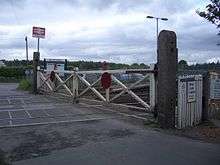

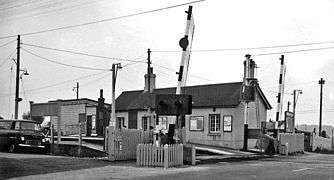
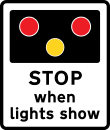

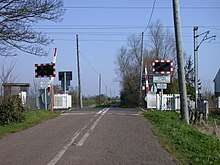

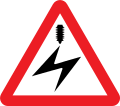
.jpg)
.jpg)


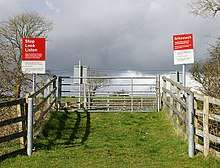

There are around 6,000 level crossings in the United Kingdom, of which about 1,500 are public highway crossings.[1] This number is gradually being reduced as the risk of accidents at level crossings is considered high. The director of the UK Railway Inspectorate commented in 2004 that "the use of level crossings contributes the greatest potential for catastrophic risk on the railways."[2] The creation of new level crossings on the national network is banned (the exception being reopening unavoidable crossings on new/reopening railway lines, and on heritage railways), with bridges and tunnels being the more favored options. The cost of making significant reductions, other than by simply closing the crossings, is substantial; some commentators argue that the money could be better spent. Some 5,000 crossings are user-worked crossings or footpaths with very low usage. The removal of crossings can improve train performance and lower accident rates, as some crossings have low rail speed limits enforced on them to protect road users (e.g. AOCLs). In fact, between 1845 and 1933,[3] there was a 4 miles per hour (6.4 km/h) speed limit on level crossings of turnpike roads adjacent to stations for lines whose authorising Act of Parliament had been consolidated in the,[4] although this limit was at least sometimes (and possibly often) disregarded.[5][6][7]
History
In the United Kingdom, major crossings were normally situated within easy sight of a signal box, and usually directly adjacent to the signal box, to ensure that the signalman could verify that the road was clear before allowing a train onto the crossing by switching the semaphore signals to clear. Gated level crossings were mandatory from 1839, but initial rules were for the gates to be ordinarily kept closed across the highway[8]. The familiar traditional form of road crossing on British railways dates from 1842 onwards[9] consisted of two or four wooden gates (one or two on each side of the railway). These prevented road traffic from crossing when closed, and when open lay across the railway to prevent horses and livestock inadvertently escaping from the road to the railway. Originally the signalman (or an assistant) had to leave the box in order to open or close the gates but from the late 19th century mechanical systems were developed whereby turning a wheel in the box manually operated the gates. This also allowed the crossing gates to be interlocked with the signal controls, making the crossing quicker in operation and increasing safety. Where a signal box was not nearby but road traffic still warranted a full gated crossing a dedicated crossing keeper would be employed, often living in a railway-owned cottage adjacent to the crossing and in communication with the signal boxes via the telegraph system. Many gated crossings have been replaced by lifting barriers, which are easier to operate and mechanise. Gated crossings on back-roads with crossing keepers still exist in places (many crossings though are user-worked nowadays), although the keeper does not often live in a dedicated crossing keeper cottage. Instead they may use a medium sized cabin, while crossing keeper cottages are now used to house non-railway staff or no one at all.
The use of pedestrian crossings at stations in the past was common, and it was the norm for passengers to walk across the line between platforms. It is still common in many other countries, and on lines with less traffic in the UK. At Settle, for example, before the footbridge was installed in the 1990s, while passengers from Leeds walked across the line the driver's kettle was topped up with hot water. Due to ongoing safety issues with such crossings, and the increase in danger at some, footbridges with steps (and possibly a ramp/elevator) replace these. A few exceptions survive, such as at Carmarthen or on heritage railways, where they are used to let passengers who cannot climb stairs to the footbridge move between platforms.
In 1955 various European countries were visited and automatic crossings examined by two inspecting officers from the Railways Inspectorate (HMRI), two road engineers from the Ministry of Transport, and two officers from the British Transport Commission (see Hixon rail crash). They visited 46 crossings in 10 days in three countries; Belgium, France and the Netherlands. The report was signed on 14 March 1957, and automatic and automated crossings came into use, with the first automatically operated level crossing commencing operation at Spath near Uttoxeter in Staffordshire in May 1961.[10] Automatic half-barrier crossings later came into being after another enquiry abroad in 1963, consisting of a single arm each side of the road, which block only oncoming traffic leaving the exits clear for trapped occupants. Half barriers were considered to have an advantage as they have a lesser closure time and do not require to be interlocked with signals, but cases where impatient motorists have driven around the barriers have raised safety concerns. On lightly-used railways such as the Heart of Wales Line, many crossings were, and still are, sited next to station stops or other stopping points, and were made to be crew operated. The guard pushes a plunger to operate the crossing, and on completion of the crossing sequence, the train can cross. These trainman operated crossings (TMOBs) still exist today.
After the Hixon rail crash in 1968, it became clear that more warnings were needed for large vehicles at AHBCs (Automatic Half Barrier Crossings). The vehicle in question (a low-load transporter carrying a large electrical transformer), despite being escorted by police, was struck by a train whilst crossing the tracks at 2 miles per hour (3.2 km/h) on an AHBC installed a year before. The changes made to AHBCs were additional information signage, telephones to signal boxes and the addition of a preliminary amber light to the pair of red lights at all crossings (plus a now defunct 'Another train coming' illuminated box; now just a piece of signage is needed). This made AHBCs much safer and less liable to accidents, although some have still occurred since then (e.g. Ufton Nervet rail crash). Provision of telephones at these crossings had been opposed by Colonel Reed of the Railways Inspectorate (HMRI), although some BR managers still installed them. Colonel McMullen of HMRI had stated in 1957 that if AHBs (Automatic Half Barriers) were adopted "the principle must be recognised that it is the responsibility of the individual to protect himself from the hazards of the railway in the same was as from the hazards of the road". Wynns, the operator of the low-load transporter had received a terse reply from British Rail when they wrote about a near-disaster with a slow transporter in Leominster in 1966.[11]
The Automatic Open Crossing (now known as AOCL, with the L standing for Locally monitored) was introduced in 1963. These have no barriers, a St Andrew's Cross above each warning light, and have an indicator light to show correct working. The first to be installed was at Yafforth in North Yorkshire in 1963. These crossings were cheaper than installing AHBCs and were much suited to quiet country lanes, which is why many more were installed in the 1970s, albeit destined to be replaced by AOCRs (Automatic Open Crossing Remotely monitored) as they had a greater line speed potential and were even cheaper than AOCLs. The first of these AOCRs to be installed was at Naas crossing near Lydney, Gloucestershire in 1983. These continued to be installed until the Lockington rail crash occurred in 1986, which saw the demise of this type of crossing with nearly all AOCRs being upgraded to AHBCs. Only two remain in the UK at present; one on the national network (Rosarie, near Keith, Moray) and one on a heritage railway (NYMR at Pickering). Other open crossings with no lights, alarms or barriers are seen on very underused lines with a low speed limit, and aren't too much of a problem for the railway because of the slow speed they are crossed at.
Since then, more upgrades have happened with the use of CCTV and obstacle detection systems (since 2010) increasing. These crossings are controlled by signal boxes from great distances and do not require extra staff. The Ufton Nervet rail crash in 2004 was an eye-opener for many people involved with level crossings and since then the highlight on crossing safety has increased, with crossings being closed or upgraded; most notably AOCLs being upgraded to Automatic Barrier Crossing Locally monitored (ABCL) status. In 2009 after the Halkirk crossing crash in Scotland, it was seen that the AOCLs on the network were the most dangerous crossing and a scheme to eradicate them was put forward. In order to do it quickly and cheaply, the full conversion to ABCL status was not done, and instead the simple addition of barriers to create an AOCL+B was the go to option. Upgrades and closures still continue into the future, with newer systems (and trials of different equipment) such as the AFBCL (Automatic Full Barrier Crossing Locally monitored) being installed in Ardrossan in 2018.
Safety
After the Ufton Nervet rail crash, there have been increased efforts to review the placing of level crossings and to eliminate them where this is practicable. In the UK it has also been suggested that cameras similar to the type used to detect drivers who run traffic lights be deployed at level crossings, and that penalties for ignoring signals should be much more severe.
British Transport Police typically prosecute motorists who jump the barriers, for either trespass or failing to conform with a traffic signal. A particular problem has been that the responsibility for road safety at crossings is entirely outside the control of the railways. In 2006 there were legal proposals to permit Network Rail to be involved in the road side safety of crossings. This would allow the introduction of anti-slip surfaces and also barriers to prevent motorists driving around crossing arms and, it is hoped, reduce the number of crossing-related deaths.
Network Rail is pursuing a policy of closing level crossings at the rate of over 100 a year in the interests of safety, and replacing them with road bridges or footbridges.[12] The number of level crossings on rail lines controlled by Network Rail went from 7,937 in 2003-04[13] to 6,322 on 19 January 2014,[14] and 5,948 by 2016.[15]
For the episode of British motoring television programme Top Gear on 25 February 2007, Network Rail staged an incident in which a locomotive was driven into a Renault Espace at around 80 miles per hour (130 km/h) at an AHB level crossing at Hibaldstow, Lincolnshire to graphically illustrate the dangers of "running the risk" (see British Rail Class 31 in the media).
Equipment
Modern level crossings in Britain use a variety of different equipment to stop any traffic when an oncoming train crosses:
Warning lights
The modern warning lights used on level crossings in the UK consist of one amber light at the bottom and two red lights at the top, all on a black board with a checkerboard outline in red and white (the red and white borders weren't introduced until 1992; the borders were just white beforehand). The amber light has been in existence since the Hixon rail crash; previously there were just two red lights. The whole warning light module is known colloquially as a "wigwag" (due to the nature of the alternate flashes) and are also used at some airports; fire stations; police stations; and ambulance stations in the UK. When a level crossing activates, the yellow light is usually illuminated for 3–5 seconds and then the two red lights flash alternately for the duration of the closure. The lights are normally rectangular and landscape orientated, but where space is limited or to improve visibility special lights can be fitted that are portrait orientated. In some cases a now non-standard traffic light type was fitted (still seen at Marshbrook, Minffordd and on the Isle of Man), consisting of the individual lights arranged vertically in a red–amber–red arrangement. Many of the lights nowadays are Unipart Rail / Dorman LEDs (formally National Railway Supplies/NRS until 2006/2007) due to the cost efficiency, easy maintenance, and clarity, the first LED wigwags were trialled at Bentley Heath level crossing in 2006 (branded NRS at the time) but not fully adapted until July 2007. Incandescent halogen lights by companies SGE, GEC Forest City & National Railway Supplies (NRS) are no longer manufactured as they are wasteful on electricity and can cause accidents such as at Beech Hill Crossing in Nottinghamshire, in which a fatality occurred due to the lights' dimness in the low sunlight[16]. However old halogen lights and even LED lights are sometimes donated to heritage railways and used at their crossings, or simply scrapped in the case of some halogen lights. As well as road traffic, smaller pedestrian lights are used in populous areas or at dangerous crossings, where extra warning is needed. These consisting of a flashing red silhouette of a pedestrian, similar to what you would see at a pedestrian crossing. Finally, examples of AOCL(+B) type crossings with two tracks usually have a warning light that signals when a second train is due. If one train were to cross, and another is only seconds away, a small red light with the overlay 'another train coming' in capital letters would flash. Previously at AHBCs, there was a panel with the words 'another train coming` which would flash using incandescent tubes when another train was due in quick succession, but this was discontinued in favour of cheaper signage stating the same thing in the early 1980s and weren't fully extinct until around 2007/2008 (Beech Hill LC being one of the last with the illuminated 'another train coming' sign).
Audible alarms
Originally electronic bells were used at many crossings to produce a loud ringing alarm when the crossing was activated, and stopped when the barriers descended. This could either be a sequenced bell that would ding once or twice a second, or a constantly ringing bell. These bells became normal practice until audible tone alarms started to be installed, replacing the ageing bells. Bells on some crossings can still be seen today although some are not as audible as today's standards. They can come attached to the post that the warning lights are on, or can come fitted to some older barriers.
Audible alarms (also known as 'Yodalarms') were first implemented on crossings in the late 1970s/early 1980s and continue to be used today as they are the safest way of warning traffic and pedestrians audibly of an approaching train. The Yodalarms (depending on what model) usually have different tones, alternate rates and different volumes (controlled by potentiometers) at different crossings, depending on how busy the crossing is, and whether residents are living nearby. Modern alarms have night modes (controlled by the crossing relays) that lower the volume in the night, the pitch usually goes lower and the alternate rate normally goes faster (depending on which yodalarm model it is), on some crossings (mainly of the older types) the alarms are switched off completely by the crossing controller at night. The alarm sounds from the moment the amber light is illuminated up to the point the barriers shut on a full barrier crossing, and the crossing is deactivated on all automatic crossings. The Yodalarm YO3 Electronic Alarm (Clifford & Snell / R.Stahl) type alarms were the original ones used and still are the most common. They produce a two tone (high pitch bleep, followed by a lower pitched bleep) alarm, that does tend to change over time due to general wear. They are found at almost every MCB crossing in Britain, and many more besides. At crossings with half barriers and two tracks, if another train is approaching after a first has crossed, the alarm will double in speed to inform the users at the crossing that another train is due. Another type of alarm is the A105NAX Electronic Alarm (e2s), which started to be implemented on some crossings in 2010, and produce a more lower pitch assertive two tone sound. These alarms function the same as a Yodalarm at a half barrier crossing except their main property is that intermittently a verbal warning will play. This can either be "Warning, more than one train may be approaching" repeated twice during closure, or "Warning, another train is approaching" repeated twice if another train is due.
Gates and barriers
Wooden gates were the most common form of protecting level crossings in the UK, and were operated either by a signalman or a crossing keeper. All gated crossings across public highways had each gate fitted with a large red circle or more rarely, a diamond, to highlight that the gate was closed. In some cases, the gates were wheel operated, allowing safer operation away from the road. Gates lock the railway from the road in most cases in order to stop livestock that may be crossing from running onto the rails. When a train was due, they would swing across the road (some having a wheel on the bottom of the gate to help with this) and would interlock with the signalling systems to set signals to clear. However due to the ongoing modernisation of the railways these crossings are becoming obsolete and are mainly seen nowadays on heritage lines and very underused lines in countryside locations. Semi-modern electric gates from the 1980s replaced some older gates in use, and they had a motorised wheel that drove the gate across the road. Although these have nearly all been replaced due to reliability issues, most notable at Redcar.[17]
Barriers are the normal level crossing protector to be seen in the UK and now come in various models. All barriers at crossings are illuminated with barrier lights on the barrier arm, and are highlighted in red and white reflective stickers. Half barriers at level crossing are a simple boom arm that descends on the left hand foot way and left hand lane(s) of a road when the crossing activates and the warning lights have been on for about 10 seconds. Full barrier crossings have either two barriers covering the whole width of the road on either side, or four barriers covering half of the road on either side, that descend on the left hand lanes first and then the right hand lanes. These are supplied with a white skirting (red and white in older crossings) that fold up in the upright position, and stops small children, animals, and potential trespassers from crossing when the barriers are down for long periods. Where pedestrian traffic is sparse or there is a barrier separating the foot way from the road, only partial or no skirting ('skirts') may be used. In rare cases, both full and half barrier crossings can have three barriers that all descend at once.
Electric barriers were used at first, made by GWE (Godwin Warren Engineering). These were used at crossings in the 1960s, 70s and 80s. The barriers had a pogo-stick like peg at the end (on full barrier crossings) to assist them when reaching the closed position. Field & Grant Hydraulic barriers were also installed at around the same time as the GWE barriers from the 1960s until the early 1980s, and were hydraulically powered. They could be much longer than any current electric barrier, but the hydraulics were hard to maintain and had noisy hydraulic motors, so have nearly all been replaced. They have only been used at full barrier crossings as they require long barriers to cover the road, which these were more suited for. The former two are being phased out by modern electric barriers such as the Mk2 type barriers by (former) 'Smiths Industries Hydraulics Company' (in 1985), who were re-branded 'SPX Fluid Power' in 2001, and re-branded again to their current name 'SPX Rail Systems' (as of 2005); these being the most used type today. These use gravity to descend and raise with electric motors, or more rarely, hydraulics. Barrier technology has been improving in the 2010s, with many more systems being trialled and installed at crossings in the country. Invensys Rail S60 / Siemens barriers are a relatively new barrier design which was given a 'Certificate of Acceptance' by Network Rail in June 2012. They have been used at a vast range of MCB-OD crossings, originally trialled in Cheshire and Shropshire. The barrier design comes from the many railroad crossings in the United States. Invensys and Siemens had to make additional fittings (such as a housing fork, stand, caging and skirting) along with sufficient safety measures to allow the barrier design to be accepted in the UK. After trials at numerous crossings, no more of these barriers have been fitted since they have become unreliable (requiring maintenance) and occasionally unsafe (in strong winds). This may however now be a claim just for the English government, as one new crossing in North Wales (Tyn Y Morfa) has recently been fitted with this type of barrier (in March 2018).[18]
As well as these, as mentioned in the first paragraph, the troublesome gates at Redcar were replaced in 2015 with a new, exclusive telescopic sliding gate that slides across the road when a train is due. These were fitted with modern red and white reflective stripes as well as the red circle warning a seen on gates almost 100 years ago. The gates were implemented as a trial, and their future does not seem good as they have failed a couple of times in recent years.[19]
Finally, the most recent tests of not only barriers but barrier system was undertaken at Selby Road level crossing near Doncaster in April 2018.[20] These were Bombardier's EBI Gate 2000 barriers (also called the EBI Gate 630) which were used alongside the Bombardier EBI Gate 2000 system.[21] These have barrier arms that are safer in the event of them being hit, as they break in set places. They also have supporter pogo-sticks at the end of the barrier as did the GWE barriers beforehand. Several more of these crossings are due to be fitted and trialled in the north east.
Types of crossing
MG - Manually controlled Gates
These crossings are the traditional type, with wooden (or nowadays metal) gates that protect the railway from vehicles when closed, and shut off each side of the railway to vehicles and animals when open. They were on every crossing until technology upgraded the equipment available. Some crossings still have gates either hand operated; operated by a wheel; driven by a motor; or more recently at Redcar, gates that are electrically telescopic. Despite blocking the railway off entirely, there have been virtually no accidents at gated crossings, with the last being at Lingwood, Norfolk[22] in which a railhead treatment train crashed into the gates at a crossing in the village.
MCB - Manually Controlled Barriers
This type of crossing has lights and alarms that operate when closing, and full-width barriers (either electric, hydraulic or wheel operated) that shut the entire road off to traffic. The first crossing of this type was tested at Warthill, North Yorkshire in 1952. The crossing is controlled by an adjacent signalbox, or in the case of an MCBR (Manually Controlled Barriers Remotely monitored), a signalbox no less than 1⁄4 mile (400 m) in clear sight of the crossing. An example of this type of crossing is at Driffield, East Riding of Yorkshire. Normally an MCB crossing either has two full road width barriers, or four half road width barriers, but in rare circumstances the crossing may have three barriers. Furthermore, in some circumstances the crossing may not have road warning lights, and will only be supplied with an audible warning such as an alarm or bell. One example of this configuration is the crossing in Arbroath, Angus.
MCB-CCTV - Manually Controlled Barriers with Closed Circuit Television
These crossings are controlled from a signaller via CCTV cameras mounted in close proximity to the crossing. They work in the same way as MCB crossings with the bonus that the CCTV can be viewed if an incident has occurred. These crossings have replaced redundant signal boxes on various lines across the country. The first crossing of this type was trialled at Funtham's Lane, near Peterborough, Cambridgeshire in 1970.
MCB-OD - Manually Controlled Barriers with Obstacle Detection
These crossings are MCBs with the addition of obstacle detection equipment, developed and tested at a level crossing at Filey, North Yorkshire, in 2010. These use LIDAR, radar and cameras to detect if the crossing is blocked by any vehicle, and cameras to record number plates. They also include lasers and reflectors to scan the crossing and see if it is blocked. These crossings are becoming common on some lines, such as the East Coastway Line and the Peterborough to Lincoln Line. They are operated by a signaller simply pressing a button, but they can switch on CCTV cameras at the crossing if they so wish.
MCB-OC - Manually Controlled Barrier crossing On Call
These crossings are exactly the same as MCB-CCTV crossings except the barriers stay down and the lights stay off. When a user wants to cross, they have to press a button to notify the signaller, who will raise the barriers if there is no train. There are only a handful of these in the UK, one being at Barnetby, Lincolnshire.
AHBC - Automatic Half Barrier Crossing
The first crossing of this type in the UK was installed in the town of Spath, near Uttoxeter in Staffordshire, and began operating on 5 February 1961. These crossings have two half-barriers that block the entrance lanes to the crossing, as well as lights and audible alarms. They are entirely independent and do not interlock with signals, although they are monitored by a signaller to check for any failures. In existence since the first automatic crossings, they are common on back lanes, but are becoming less common at stations, because they are not as safe as a MCB crossing. 100 miles per hour (160 km/h) is the maximum line speed over these crossings and only a maximum of two tracks can be crossed. In recent years, Network Rail has been trying to make AHBCs safer by adding the brand of speaking E2S alarms to crossings, in order to alert drivers and persons using the crossing of second trains approaching, as many drivers become impatient at these crossings.
AOCL - Automatic Open Crossing Locally monitored
These are crossing with no barriers, but with lights and an audible alarm. Designed for low traffic lines, the first was installed at Yafforth, North Yorkshire in 1963. With a line speed of 55 miles per hour (89 km/h), the crossing must be checked by the driver that it is clear. On the railway, a white light flashes when the crossing is operating correctly, and a red light flashes when the crossing is open to road traffic. However, although popular at first, they are not particularly safe and are rare these days due to barriers being fitted at these crossings.
AOCR - Automatic Open Crossing Remotely monitored
These crossings were popularly installed when one was first trialled in 1983 (at Lydney, Gloucestershire), because they lowered costs due to the lack of barriers, and they could be used on many country lanes. Acting in the same way as an AHBC, they do not interlock with signals, but they had a 75 miles per hour (121 km/h) line speed. After the Lockington rail crash in 1986, their demise began due to their safety issues, and now only two still exist; one each in England and Scotland at Pickering, North Yorkshire and near Keith, Moray respectively.
ABCL - Automatic Barrier Crossing Locally monitored
These crossings were a complete upgrade of AOCLs that came about after the Lockington rail crash, due to a need to upgrade many AOCRs and AOCLs. They are AOCLs with the addition of barriers and AHBC signage. They have a maximum line speed of 55 miles per hour (89 km/h) and the first to be installed was on the A146 Beccles bypass, Suffolk, in 1988.
AOCL+B - Automatic Open Crossing Locally monitored + Barriers
These have existed since 2012, the first being at Ardrossan Harbour, North Ayrshire, and are the cheap version of the ABCL, brought about by RAIB suggesting Network Rail fit barriers to AOCLs after a crash at an AOCL in Halkirk, Highland[23]. In an AOCL+B upgrade, the barriers are added into the AOCL's circuitry instead of replacing the whole system as at an ABCL upgrade. They can be recognised by the alarm switching off before the barriers rise once a train has passed, and by not having telephones as ABCLs do.
AFBCL - Automatic Full Barrier Crossing Locally monitored
This is a recent type of crossing, the first being at Ardrossan Princes Street crossing in early 2018 and two more planned for Dingwall Middle and No.1 crossings in July and August 2018, and they are the enhanced version of the ABCL, with full barriers. This is intended for locally monitored crossings with a high level of misuse by pedestrians, or a risk of misuse. Obstacle detection equipment (LIDAR only) is provided, since automatic full barrier crossings without them can trap a vehicle if not proven it's clear before lowering. The exit (offside) barriers will not descend unless the crossing is proved clear of vehicles and pedestrians by obstacle detection equipment. Unlike the standard full barrier type crossings, the alarms remain on when the barriers have completed their descend, just like any automatic half-barrier crossing, and will stay on until the red lights stop flashing.
TMO - Trainman Operated Crossing
On small branch lines (e.g. Cambrian Line), these crossings are common as they require no monitoring by any signallers, and simply have to be observed by the train driver as being closed. The guard will push a button close to the crossing that activates it, and once lowered the train can cross safely. These appear to be MCB type crossings to the driver, but have a much shorter closing time (with the drawback of the train having to stop completely to activate the crossing).
MWL - Miniature Warning Light crossing
These crossings are normally seen on foot crossings or private roads (where the user has to operate the barriers/gates themselves at the latter). A small set of red and green lights alert the user as to the state of the railway; green for safe to cross, red for train approaching. These started to appear around 1964, and are still common today. They have no line speed, although they have been removed from all major railway lines due to the general danger level crossings pose to them.
OC - Open crossing
The open crossing only really exists on underused country lanes crossing lines with low and/or slow rail traffic. With a speed limit of 5 mph (8 km/h) and no lights or barriers/gates, these are rare, and are only marked by the signage and the St Andrew's Cross. Many can be found in southern Kent on the Dungeness branch of the Marshlink Line, and some in Cornwall on scenic railways. Others also scatter the country.
UWC - User Worked Crossing
The most common type of crossing on the railway network (around 2/3 of the total) and also the most basic type. These can either be a basic footpath crossing; a crossing with gates and instructional signage; or a crossing with a telephone to the nearest signalbox. In order to cross safely, users must read the instructions and comply with them. Whether they have to raise the barriers, open the gates, phone the signalman or simply cross under their own judgement varies depending on the danger the crossing poses. Normally phones are provided at crossings on high speed lines.
See also
References
- ↑ "Level crossing safety". Network Rail. Retrieved 23 July 2018.
- ↑ "Rail level crossings discouraged". BBC. 7 November 2004.
- ↑ Railways Clauses Consolidation Act 1845, s.48
- ↑ Railways Clauses Consolidation Act 1845
- ↑ Attorney General v London & North Western Railway Co [1900] 1 QB 78
- ↑ The requirement that trains travel at 4mph across some level crossings was abolished by the Road and Rail Traffic Act 1933, Sch 3.
- ↑ Goodman, Michael (1977). "Railways in the Law Reports" (PDF). Trent Law Journal. 1 (1): 47.
- ↑ https://www.networkrail.co.uk/who-we-are/our-history/railway-history-feature-articles/level-crossings/
- ↑ https://www.networkrail.co.uk/who-we-are/our-history/railway-history-feature-articles/level-crossings/
- ↑ "New Summary: Automatic "Gates" Britain's first automatically operated level crossing barriers are now in operation at Spath Level Crossing near Uttoxeter. The barriers, electronically operated by an approaching train, consist of a single pole fixed each side of the road only, and are conspicuously marked with red and white bands. Additional warning is given by flashing red lights and audible alarms". Practical Motorist. 7 (81): 957. May 1961.
- ↑ "Ignorance from Arrogance in 24 seconds" by Fraser Pithie in The Railway Magazine (England): January 2018 (No 1402, Vol 164) pages 24-30
- ↑ "Level crossings". Network Rail. 2014. Retrieved 27 June 2015.
- ↑ "Railways: level crossings" (PDF). House of Commons Library. 26 January 2012. Retrieved 27 June 2015.
- ↑ "Annual Safety Performance Report 2013-14" (PDF). Rail Safety Standards Board. 2 July 2014. Retrieved 27 June 2015.
- ↑ "Annual Safety Performance Report 2015-16" (PDF). Rail Safety Standards Board. 1 July 2016. Retrieved 14 March 2017.
- ↑ https://www.gov.uk/raib-reports/collision-between-a-train-and-a-car-at-beech-hill-level-crossing-near-finningley
- ↑ https://www.gazettelive.co.uk/news/teesside-news/redcar-level-crossing-replaced-within-8581137
- ↑ https://www.networkrailmediacentre.co.uk/resources/tyn-y-morfa-lx-3
- ↑ https://www.gazettelive.co.uk/news/teesside-news/rush-hour-misery-redcar-level-14398386
- ↑ https://twitter.com/BombardierR_UK/status/985618466400096256
- ↑ https://www.railengineer.uk/2015/12/30/in-case-you-missed-it-level-crossings-come-of-age/
- ↑ https://www.bbc.co.uk/news/uk-england-norfolk-32230752
- ↑ https://www.gov.uk/raib-reports/fatal-accident-at-halkirk-level-crossing-caithness
.jpg)

.jpg)